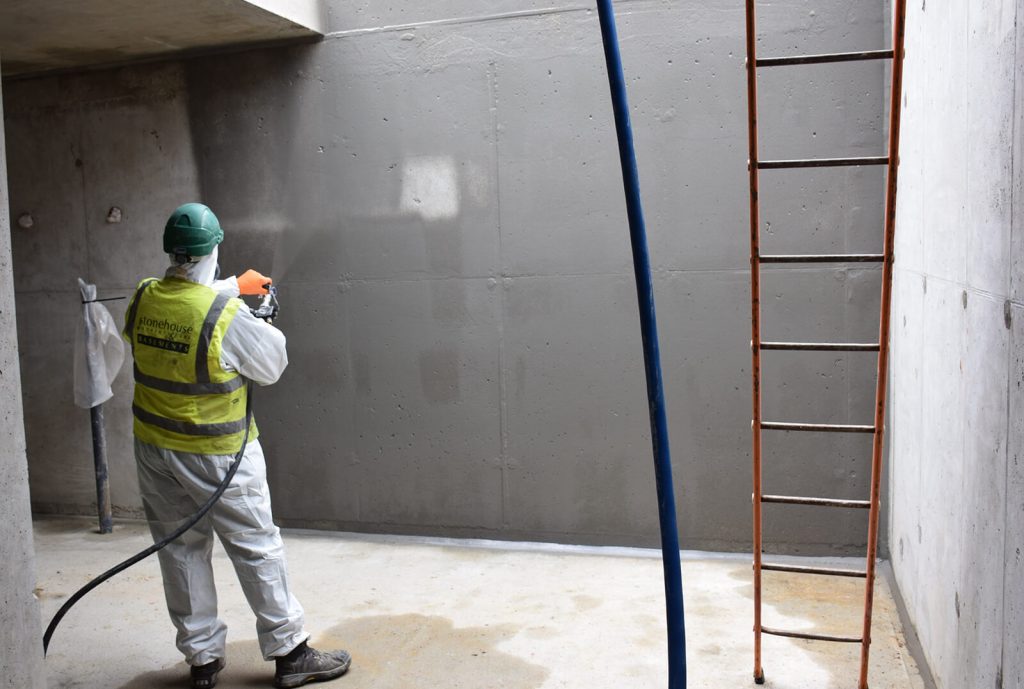01732 360 095
What is Basement Tanking?
Basement tanking, also known as ‘Type A’ waterproofing, involves applying a membrane or coating to the inside of a below-ground structure. This creates a barrier that prevents water from entering the habitable space of the property and endeavours to make the basement watertight.
What Are The Benefits of Cellar Tanking?
- Protection against water: Cellar tanking provides a barrier against water ingress, preventing damage to internal fixtures and fittings, and other related issues.
- Preservation of structural integrity: By eliminating water ingress, cellar tanking safeguards the structural stability of your cellar, preventing damage to brickwork and masonry.
- Conversion potential: Once your cellar is properly waterproofed, you can explore exciting possibilities such as basement conversions. Transform your space into additional living areas, entertainment rooms, or a home office with confidence.
- Increased property value: A dry and well-maintained cellar adds value to your property, making it more appealing to potential buyers or tenants.
What Should I Consider When it Comes to Basement Tanking?
Tanking basement walls involves the application of a waterproof coating, commonly referred to as a tanking slurry, to the walls and floor. This ensures complete protection and makes sure basement walls remain dry.
Tanking will ultimately provide a barrier which bonds with the structure and provides protection from water ingress and subsequent problems, however it is important to consider the existing condition of basement walls and floors before proceeding with a waterproofing installation.
To achieve a successful tanking system, it is important to apply it to walls and floors that are in sound and stable condition. The flow of free water should also be minimised as much as possible before applying a tanking membrane.
Attention should also be given to weaker points in the structure that may be more prone to water ingress, such as floor-to-wall junctions and construction joints or service penetrations.
However, there are cases where directly applying tanking onto the surface is not suitable. This could be due to poor wall surfaces that do not allow for a strong bond with the waterproof coating or if there is evidence of excessive movement in the substrate which could cause future cracking in the tanking membrane.
Whilst tanking membranes can be used for waterproofing floors, basements, crawlspaces, storage areas, and tunnels, it’s always recommended to get a specialist survey done first by a qualified waterproofing contractor before proceeding with any work. This will allow you to identify potential problems and suggest where an appropriate waterproofing system may be required.
Type C Waterproofing

Tanking a basement involves creating a watertight barrier that blocks water from entering, in order to prevent water ingress and damp. However, another method of basement waterproofing is the installation of a cavity drain system, otherwise know as ‘Type C’ waterproofing.
If a tanking system is not feasible or defective due to installation issues, preparation problems, or impact damage, water can enter the structure and compromise its internal space. In contrast, Type C waterproofing does not resist water pressure, therefore avoiding these issues and is generally considered as the safest form of waterproofing.
British Standard 8102:2022 defines Type C waterproofing as “drained protection” which involves accepting leaking water into voids and air spaces created by cavity drain membranes strategically placed inside structures. The system captures and depressurises incoming water before safely removing it from the property.
Newton’s Type C waterproofing solution, the CDM System, combines our decades of experience with industry-leading products, including various BBA certified cavity drain membranes along with sump and pump configurations tailored specifically for the requirements of Type C waterproofing.
Combination Waterproofing
For enhanced protection against water ingress, the BS 8102:2022 guidelines recommend that it is advisable to combine two or more types of waterproofing. Newton’s CDM System can therefore be combined with our Type A tanking systems (HydroBond and HydroCoat) as well as our Type B ‘integral’ waterproofing system (HydroTank).
Newton’s Technical Team works closely with clients to design the right combination of structural waterproofing methods that comply with current legislation and best practices.
When is Basement Tanking Not Appropriate?
There are situations where a tanking membrane may not be suitable, such as:
- In listed or historic structures where conservation officers may consider the membrane irreversible
- In buildings expected to experience excessive movement during their lifetime
- In weak structures unable to withstand water pressure against the tanking membrane
- In areas with excessive underground vibrations, such as near railway lines.
To ensure appropriate product selection for your specific project requirements, it is recommended to consult a qualified waterproofing designer.
Additional Considerations When it Comes to Cellar Tanking and Waterproofing

If you are considering converting an existing basement, we have a guide for converting domestic cellar spaces which covers many of the key points that need to be considered and assessed – including:
- Do you need an architect? One of the most important people in your whole project, and therefore one of the first people you should engage is an architect who can guide you through the entire process.
- Do you need planning permission? In most cases, unless your home is in a Conservation Area, a specially designated area, or it is Listed, then converting an existing basement will be classified as Permitted Development and will not require planning permission
- Building Regulations: Whether or not you require planning permission, your basement conversion will need building regulations approval
- Ventilation and heating: Good ventilation and heating in a basement conversion is fundamental to creating the desired internal environment and preventing unpleasant odours and condensation.
- Lighting: If your basement is to be a living space, the importance of getting natural light in cannot be overestimated.
- Party walls: Party Walls and Party Wall Agreements are something that you need to consider if you’re planning a basement conversion that will affect an adjoining property.
Effective Basement Tanking With Newton Waterproofing
Established in 1848, Newton Waterproofing is the oldest and largest independent supplier of guaranteed basement waterproofing systems in the country.
Our comprehensive range of services benefits architects, contractors, developers, groundworkers, and homeowners alike. This includes:
- award-winning sustainability initiatives
- a bespoke design service backed by Professional Indemnity Insurance
- RIBA-approved CPD seminars, and
- an advanced range of waterproofing systems
Our exceptional products are supported by a network of certified Newton Specialist Basement Contractors who provide fully guaranteed installation and maintenance services for projects of all sizes.
For more information and to find the products best suited to your basement tanking requirements, call our technical team on 01732 360095 or email tech@newtonwaterproofing.co.uk.














